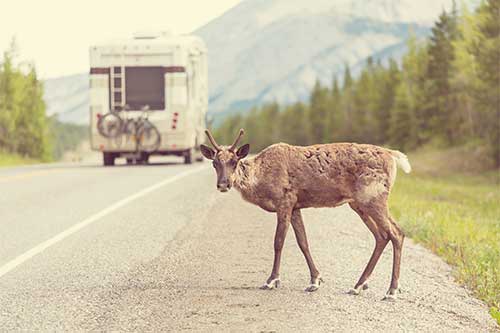No one wants to hit a deer or other animal while they’re driving. Most people value living creatures and don’t want to be the reason for killing any. Hitting a deer or other large mammal also can cause accidents as well as car damages. Handling a roadkill collision can be daunting if you’re unclear about which steps to take.
Read below for tips to avoid hitting wildlife on the road. You’ll also learn what to do if you cause or encounter roadkill and how your auto insurance coverage might cover any damages in an animal-related accident.
Jump to:
Part 1: How To Avoid Deer and Other Animals on the Road
Part 2: What to Do if You Hit a Deer or Encounter Roadkill
Part 3: If I Hit a Deer, Does Insurance Cover It?
Most Prevalent Roadkill Areas
Your potential of hitting an animal increases depending on where you are traveling. Your chances of hitting an animal in West Virginia is about 1 in 45 whereas it’s roughly 1 in 6,300 in Hawaii. In Colorado, your likelihood of hitting a deer or other large mammal is approximately 1 in 360.
Top 10 Areas for Reported Animal Crashes in Colorado
CDOT publishes online charts showing the most prevalent areas for wildlife-vehicle collisions.
In the Denver metro area, the highway where most animal-related accidents occur is on US 285 between Conifer and the CO 470 interchange. I-70 between Genesee Park and Denver and I-25 from Castle Rock to Castle Pines are also high animal collision areas, according to the Colorado Parks and Wildlife Department.
The top 10 areas for annual reported animal crashes in Colorado are:
- Jefferson County: 260
- La Plata County: 252
- El Paso County: 198
- Douglas County: 196
- Garfield County: 152
- Moffat County: 137
- Larimer County: 128
- Montezuma County: 124
- Chaffee County: 123
- Pueblo County: 119
Routes Where Wildlife-Vehicle Collisions Are Highest
The Western Transportation Institute at Montana State University says 90 percent of crashes with animals occur on rural two-lane roads. Experts believe this is because animals are less likely to approach highways where there is heavy traffic, bright lights and noise. On the other hand, collisions on side roads are less likely because vehicles are moving at a slower pace and may be able to avoid hitting animals that enter the road.
Peak Seasons, Times of the Month and Hours for Deer Collisions
Breeding data shows that fall is the time of year you are most apt to hit a large mammal such as deer, elk, moose and caribou. According to James Stickles, a researcher at the University of Georgia, deer-vehicle collisions increase during “rutting season” when deer become more active looking for mates.
CDOT data analyzing wildlife-vehicle collisions over a 11-year period confirms the UGA researcher’s assertion. The most dangerous month for hitting an animal in Colorado according to collision data is July, followed by June, November and August.
Interestingly, research conducted by Clarkson University Biology Chair Tom Langen points to moon phases as a contributing factor in determining when deer are most likely to be on the road. Research indicates that you are more likely to hit a deer during a full moon. Langen believes deer might be more comfortable moving from cover during the full moon.
Stickles’ colleague, Bob Warren, a professor at UGA’s Warnell School of Forestry, says dawn or dusk are the times of day when hitting a deer is most likely, since deer are most active during those times.
Tips to Avoid Hitting a Deer on the Road
In addition to the above statistical information, here are tips that motorists can do to avoid hitting a deer or other animal:
- Slow down and increase your reaction time in the event that you encounter an animal on the road.
- Stay alert and give yourself more stopping distance during dawn or dusk, and when weather conditions aren’t favorable, such as when it is foggy, snowing, wet or icy.
- Be especially alert whenever you see animal crossing signs – authorities post signs as warnings that wildlife are active in those areas.
- Use high-beam headlights so you can see farther at night; turn them down for oncoming traffic.
- Sweep your eyes across the road and watch for animals entering the road from the sides as well as in front of you.
- Brake if you can do so while maintaining control of your vehicle.
- If you are able, give one long blast of your horn. Deer whistles and reflectors have been proven to be ineffective.
- Don’t swerve, which can force you to lose control or put you in danger of oncoming traffic. Except in the case of a moose – the one animal you should try to swerve to avoid if possible – it’s better to hit an animal rather than put your own life in danger.
Of course, you also want to wear a seatbelt at all times, avoid distractions, stay alert and wear protective gear if you’re on a motorcycle.
It’s important to also be aware that deer and other animals often travel in groups. “In many instances, it’s the second deer that crosses the road that gets hit,” said Warren.
Sources:
https://www.codot.gov/projects/archived-project-sites/sh9wildlife/human-animal-collision-reports/Road%20Kill%20Data.jpg/view
https://www.codot.gov/programs/environmental/wildlife/data/annual-roadkill-reports

